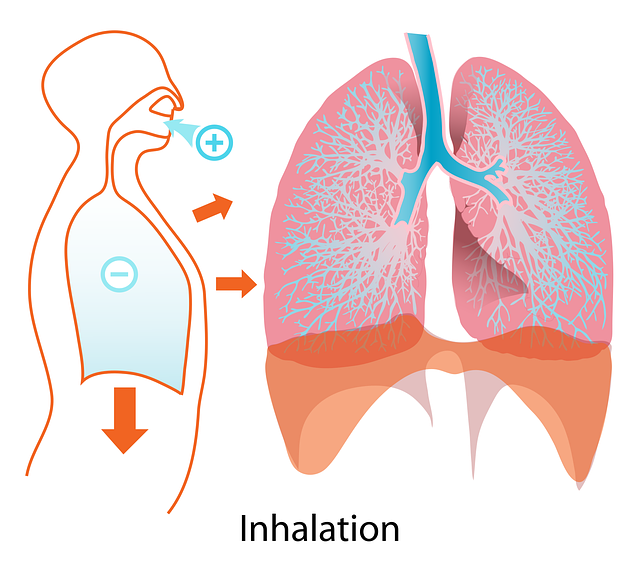X-rays, CT scans, ultrasound, and MRI are non-invasive imaging tools for pneumonia diagnosis imaging. X-rays provide early detection of lung conditions like inflated alveoli or consolidations. CT scans offer detailed 3D images, helping identify fluid buildup, collapsed lungs, or abscesses. Ultrasound offers real-time views and is cost-effective. MRI provides precise insights into soft tissues, visualizing subtle changes caused by pneumonia, and is safe for routine use.
Medical imaging plays a pivotal role in diagnosing lung and chest conditions, offering crucial insights for accurate treatment. From quick X-ray checks to detailed CT scans, these technologies provide non-invasive windows into the body’s intricate workings. This article explores four primary imaging types: X-rays, CT scans, ultrasound, and MRI. Each offers unique benefits, enabling healthcare professionals to effectively diagnose conditions like pneumonia, monitor lung function, and assess chest abnormalities.
X-rays: Basic Lung Visualization
X-rays serve as a fundamental tool in medical imaging, offering a straightforward yet powerful method for visualizing the lungs and chest. This non-invasive technique uses low-energy radiation to produce detailed images, enabling healthcare professionals to identify various conditions. When it comes to pneumonia diagnosis imaging, X-rays play a pivotal role by revealing signs such as inflated alveoli, consolidations, or pleural effusions, aiding in the early detection and management of this respiratory illness.
By projecting an invisible beam of radiation through the body, X-ray images provide a clear view of internal structures. In the context of lung health, these images can highlight anomalies, including infections, tumors, or fluid buildup, allowing for accurate diagnosis and guiding treatment decisions. This accessibility and efficiency make X-rays an indispensable starting point in evaluating chest-related issues, especially when considering pneumonia diagnosis imaging protocols.
CT Scans: Detailed Cross-sectional Images
CT scans, short for Computerized Tomography, are a powerful tool in medical imaging, offering detailed cross-sectional images of the body’s internal structures, including the lungs and chest area. This non-invasive technique uses X-rays to create multiple images from different angles, which are then combined by a computer into highly detailed 3D pictures. The result is a comprehensive view that allows healthcare professionals to detect even subtle abnormalities in the lungs, making it an invaluable method for pneumonia diagnosis imaging.
With its ability to provide clear, high-resolution images, CT scans can help identify various conditions, such as fluid buildup, collapsed lungs, or abscesses, enabling early and accurate detection of lung infections or other pulmonary issues. This advanced technology plays a crucial role in assisting doctors in making informed decisions for effective treatment planning, especially when considering the severity and progression of pneumonia.
Ultrasound: Non-invasive Real-time Views
Ultrasound is a non-invasive medical imaging technique that offers real-time views of internal body structures, including the lungs and chest. It uses high-frequency sound waves to create images, providing a safe and cost-effective way to diagnose various conditions. In the context of pneumonia diagnosis imaging, ultrasound can help detect fluid buildup in the pleural space, a potential indicator of pneumonia. The real-time nature of ultrasound allows for dynamic assessments, making it useful for monitoring treatment progress and identifying complications.
This imaging method is particularly beneficial for patients who cannot undergo more extensive procedures due to health risks or preferences. Ultrasound’s ability to visualise lung abnormalities, such as consolidative changes and pleural effusions, aids in the early detection of pneumonia, enabling prompt treatment interventions.
MRI: Comprehensive Organ Assessment
Magnetic Resonance Imaging (MRI) is a powerful tool for assessing organs and soft tissues, making it invaluable in lung and chest diagnoses. Unlike other imaging modalities, MRI provides detailed, comprehensive insights into various pulmonary conditions. It excels in visualizing structural abnormalities, such as those caused by pneumonia, allowing radiologists to accurately assess the extent of inflammation or damage.
Moreover, MRI can detect subtle changes in lung parenchyma, pleural effusions, and even identify small nodules or masses, making it a key imaging modality for early and precise pneumonia diagnosis. Its non-ionizing nature also makes it safe for routine use, ensuring patients are exposed to minimal radiation during the procedure.
Medical imaging plays a pivotal role in accurately diagnosing lung and chest conditions, from simple X-rays providing basic visualization to advanced MRI scans offering comprehensive organ assessments. CT scans deliver detailed cross-sectional images, while ultrasound offers non-invasive real-time views. When it comes to pneumonia diagnosis imaging, these modalities enable healthcare professionals to swiftly identify and treat infections or other pathologies within the lung and chest regions, ultimately enhancing patient outcomes.
